My SciELO
Services on Demand
Article
Indicators
-
 Cited by SciELO
Cited by SciELO
Related links
-
 Similars in
SciELO
Similars in
SciELO
Share
Podium. Revista de Ciencia y Tecnología en la Cultura Física
On-line version ISSN 1996-2452
Rev Podium vol.18 no.2 Pinar del Río May.-Aug. 2023 Epub Aug 18, 2023
Original article
The somatotype of the high-level performance female Cuban baseball player
1Universidad de Ciencias de la Cultura Física y el Deporte "Manuel Fajardo" (UCCFD). La Habana, Cuba.
2Instituto de Medicina Deportiva; Red Iberoamericana de Investigadores en Antropometría Aplicada. La Habana, Cuba.
The somatotype is the classification of the human figure according to three sequential elements: endomorphy or relative adiposity, mesomorphy or relative skeletal muscle development, and ectomorphy or relative linearity. The specific objectives of this study were to establish reference data for the somatotype of the team and by playing positions in Cuban female baseball players, and to compare the somatotype characteristics between playing positions, with an international population. Twenty-one athletes were evaluated through the Heath-Carter anthropometric somatotype technique; all were members of the national team that participated in the first Caribbean Cup and in the 2022 Pan-American qualifier. The age of the athletes was the chronological and sporting average of 26.8 and 12.4 years, respectively. The players were divided into four groups: pitchers, fielders, infielders, and first basewomen + catchers, and their average somatotypes were 4.5-5; 5-2.2; 4,3-4; 7-1.4; 4,5-4; 5-1.5; 4,2-5 and 5-1,7. The somatotype was not significantly different between players of different positions (p d" 0.05). The pitchers were the most homogeneous among the positions. Of the thirteen somatotype categories described, the Cuban players showed six. The dominant category was the mesoendomorphic somatotype and the anthropometric somatotype of the Cuban player was similar to that of the international player.
Key words: Baseball; constitution; somatotype.
INTRODUCTION
According to Stewart (2010), in one of the most current definitions, kinanthropometry is the academic discipline that involves the use of anthropometric measurements in relation to other specific parameters and/or subject areas, such as human movement, physiology, and sciences applied to health.
Kinanthropometry is one of the sciences applied to sports that has had the most international impact in the history of the Cuban sports movement. The innumerable publications and own methodologies show a highly standardized work system for the Cuban milieu (Carvajal, 2017, Carvajal 2021).
In this area of knowledge, the sport that has the greatest lack of information that prevents the evaluative work of the athletes, within the framework of sports preparation, is women's baseball. After a search carried out in databases such as PubMed and Scielo, it was found that this limitation persists internationally, which in the long run prevents having a clear idea of what distinctive features should be taken into account when select or compete at the highest level.
The most recent international publications have studied the pitcher, his bone and muscle mineral composition, as well as the mechanics of pitching (Lizzio, et al., 2020; Sada, et al., 2020; Montenegro, et al., 2021; Manzi, et al., 2022 and Nose, et al., 2022) . Other studies have focused on the study of adaptations to training loads with the dual energy X-ray absorptiometry technique (Tenforde, et al., 2018; Peart, et al., 2019; Czeck, et al., 2019 and Dobrosielski, et al., 2021). Finally, Watanabe et al. (2019) compared the physical condition at the end of the preseason and the performance of the games of the season, in professional baseball players from Japan.
In Cuba, the studies of sciences applied to this sport are increasing, as demonstrated by García et al. (2019), Arce et al. (2020), Cañizares et al. (2020) , Rios et al. (2020), Crespo et al. (2021), Durañona et al. (2021) and Pérez et al. (2021) who have dedicated their research to baseball from different angles, whether in studies related to the mechanics of pitching, performance and the field of psychological studies of pitchers, such as improving the preparation of pitchers and batters.
One of the traits that provide more information about the optimal characteristics of baseball players is the anthropometric somatotype of Heath-Carter (1990) based on the quantification of adiposity, skeletal muscle development and relative linearity in a sequential manner. No report was found in the specialized literature that distinguishes the anthropometric somatotype of this type of player; therefore, the present work aims to establish reference data for the somatotype of the team and by game positions in Cuban female baseball players, and to compare the characteristics of the somatotype between game positions and with an international population.
MATERIALS AND METHODS
A descriptive and prospective research was carried out that covered the period between the pre-competitive stages where the athletes prepared to participate in the first Caribbean Cup (April 2022) to the Pan-American baseball qualifier (June 2022).
In total, 21 athletes were evaluated, the composition of the universe according to the playing positions was six pitchers, seven fielders, eight infielders (including a first basewoman and three catchers), the catchers and the first basewoman joined for the study and that make up the group of first base + receivers. The average chronological and sporting age of the group was 26.8±4.8 and 14.2±4.6 years.
Of the universe, 33 % were mixed race, 22 % black, and 45 % white. All the athletes studied gave their consent to carry out the anthropometric tests and to use the data to improve the quality of medical control of sports training. The study complies with internationally established bioethical standards (World Medical Association).
The measurements for the determination of the anthropometric somatotype were carried out by level I and II anthropometrists of the International Society for the Advancement of Kinanthropometry (ISAK), who completed their restricted and full profile certifications during this assessment exercise of the baseball players and were carried out at the "Manuel Fajardo" Higher School of Physical Education, during the preparatory concentration of the athletes.
The equipment used included a scale (Detecto, USA) with a precision of 0.1 kg, for measuring body weight; two stadiometers (Holtain, United Kingdom) with a precision of 0.1 mm, for measuring height; four skinfold calipers (10 g/m3) accurate to 0.2 mm (Holtain, UK); two 1 mm precision compasses to determine bone diameters and three 1 mm precision tape measures (Holtain, United Kingdom) to determine circumferences.
Therefore, the anthropometric measurements were developed according to the protocol of the ISAK Esparza-Ros et al. (2019) always in the morning. The technical error of the gauges was less than 4.3% for skinfolds (subscapularis, triceps, supraspinal, calf) and less than 1 % for the rest of the measurements, including diameters (humerus and femur), circumferences (flexed arm and calf), weight and height. With these measurements, the somatotype was determined in an Excel spreadsheet designed for this purpose.
The calculation and qualification of the anthropometric somatotype, as well as the representation made in the somatocharts were carried out using the Heath-Carter methodology. The quantitative value derived from each component was categorized on a scale that defines values from 0 to 2.9 as low, from 3 to 5.4 as moderate, from 5 to 5-7 as high, and values greater than 7 as very high. To determine the somatotype frequencies, the 13 categories described by these same authors were taken into account.
The somatotype dispersion index that represents the area occupied by all individuals at the population level in the somatochart was determined by the Heath-Carter methodology. For the design of the somatochart where the distributions of the World Cup and Cuban baseball players appear, the average somatotype and the dispersion index of each group were used; both the average values of the somatotype and the index were entered into an Excel spreadsheet designed to generate the somatochart, based on the proposed methodology.
To comply with the research objectives, descriptive statistics were used for each of the variables studied. The absolute and relative frequencies of individuals within each category of the somatotype were taken as bases. The mean (X) and standard deviation (SD) were used to refer to the average somatotype for each playing position.
To contrast the hypothesis of the equality of means between weight, height and between the components of the somatotype (endomorphy, mesomorphy and ectomorphy) by position, the Kruskal-Wallis analysis of variance was used. The statistical processing was carried out with the statistical package IBM SPSS 22.0 for Windows, from the database created. The significance level used to draw conclusions was p<0.05. The results were reflected in tables and figures.
RESULTS AND DISCUSSION
Table 1 shows the characteristics of a population group that has an average mesoendomorphic somatotype, where relative skeletal muscle development (X=5.0; SD=1.5) is dominant over adiposity (X=4.4; SD= 1.4) and linearity does not stand out from these (X=1.7; SD=1.5). Overall, adiposity and mesomorphy were moderate and linearity low.
The average height of the Cuban baseball player is 163.9 cm (SD=7.8) and she weighs 64.3 kg (SD=10.3). Pitchers and first basemen + catchers had greater body mass and height than the rest (p<0.05).
The average somatotype of pitchers and first basemen + catchers was also mesoendomorphic, with moderate adiposity and high mesomorphy; for their part, the infielders and outfielders were moderately mesomorphic-endomorphic, with equal dominance in adiposity and relative musculoskeletal development. Despite the categorical differences, no game position showed significant differences between the indicated components (p>0.05) (Table 1).
Table 1. - Descriptive statistics of the components of the anthropometric somatotype by game positions

Sig. Statistical significance of the Kruskal-Wallis test.
Eighty-three % (n=5) of the pitchers were mesoendomorphic, in the fielders 57.1 % (n=4), in the first base + catchers group 50 % (n=2) and in the players frame 50% (n=2). The rest of the distribution was in the ectoendomorphic category, with a pitcher and an infielder; endomesomorphic, two outfielders and one infielder; balanced endomorphic, an outfielder; Mesoectomorphic, a first base + catcher and mesomorphic-endomorphic, into a first base + catcher.
The spatial location of the average anthropometric somatotype (indicated in red) in the somatocards (Figure 1, Figure 2, Figure 3 and Figure 4) corroborated the Kruskal-Wallis result of equality of means, where no significant differences were found between the playing positions.
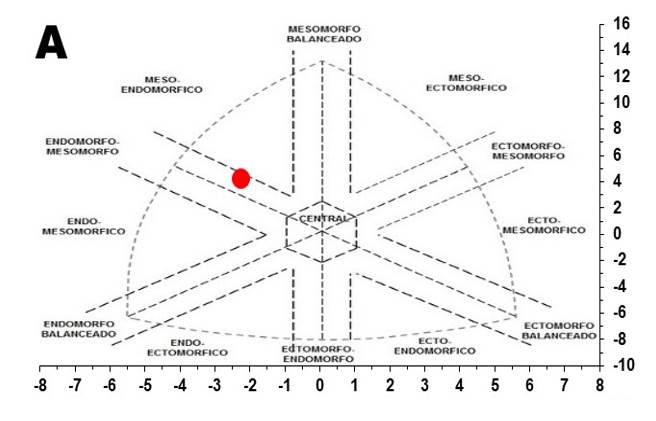
Fig. 1. - Distribution of the average anthropometric somatotype of Cuban baseball players in the pitchers (A)
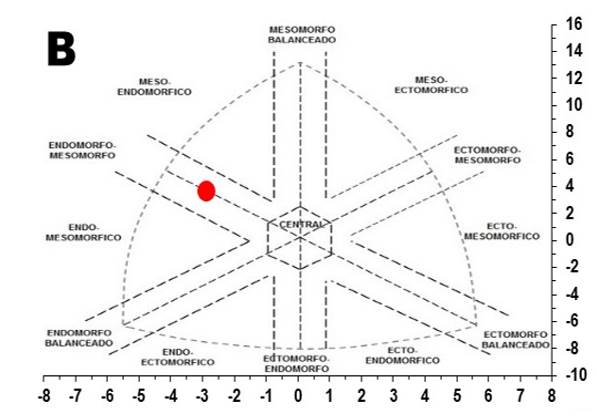
Fig. 2. - Distribution of the average anthropometric somatotype of Cuban baseball players in the outfielders (B)
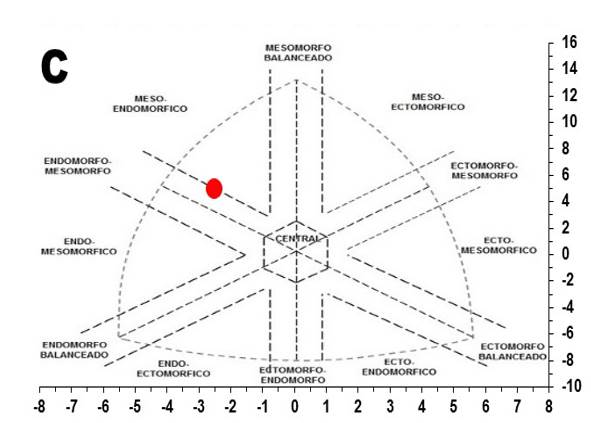
Fig. 3. - Distribution of the average anthropometric somatotype of Cuban baseball players at first base + catchers (C)
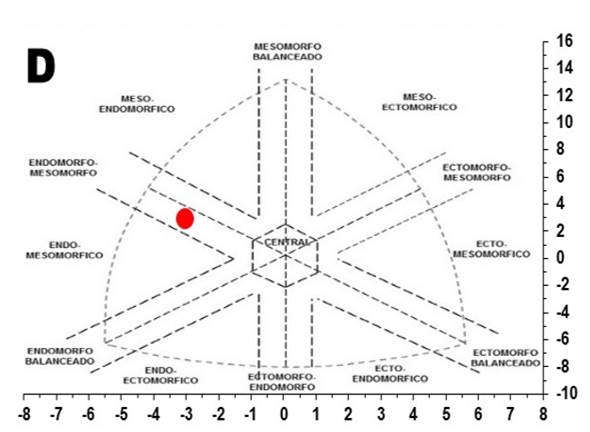
Fig. 4. - Distribution of the average anthropometric somatotype of Cuban baseball players in infielders (D)
The data available on international players participating in the world championship were provided by the Institute of Sports Medicine (IMD in Spanish) with the commitment not to disclose the data by game positions or make use of it in publications of any kind. The study was carried out in accordance with the declaration of the World Medical Association (WMA), which has promulgated the Declaration of Helsinki (2008) as a proposal for ethical principles for medical research in human beings, including the investigation of identifiable human material and information.
The sample of international players compared to the population under study has an average mesomorphic-endomorphic somatotype where relative skeletal muscle development (X=4.6; SD=1.5) is equally dominant as adiposity (X=4, 8; SD=1.5) and linearity does not stand out from these (X=1.8; SD=1.3). In this case, similarities were found with the average somatotype of the sample under study (4.4-5.0-1.7).
In figure 5, from the point of view of the population spatial distribution, population anthropometric somatotype of Cuban baseball players (blue) and World Cup players (red circle on the left), according to data from the IMD, almost 100 % of them were similar overlap and the centroid of each population coincided. The dispersion index of the World Cup players (IDS=3.84) and of the Cuban players (IDS=5.46) reflects the area occupied by the players on the somatocard: the blue area did not differ much from the red area occupied by the international players with a body mass (X=66.9 kg; SD=13) and height (X=166.4 kg; SD=6.5) slightly higher than the Cuban ones (Figure 5).
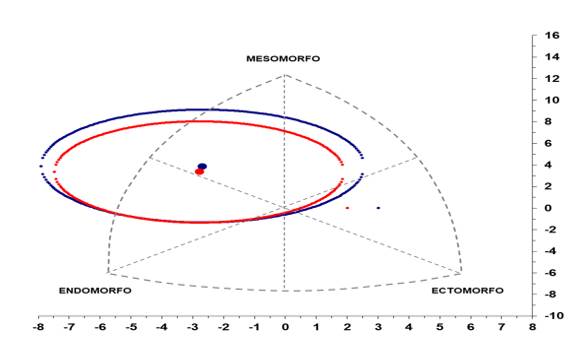 The point in the center of the distribution represents the average somatotype of each population.
The point in the center of the distribution represents the average somatotype of each population.Fig. 5. - Distribution of the population anthropometric somatotype of Cuban baseball players (blue) and World Cup players (red circle on the left)
This work corroborates that the average somatotype of the Cuban baseball player is mesoendomorphic, the same result obtained by Carvajal et al. (2018) for the male sex. Another important finding in this research is that the Cuban baseball player is characterized by having relative adiposity values higher than the average of the Cuban sports population, since only the super heavyweight categories of judo (X=6.5) and pitchers bala (X=4.5) showed greater adiposity than baseball players when they were descriptively compared with 34 sports modalities studied by Carvajal et al. (2018) in the characterization of Cuban sport.
Regarding mesomorphy, the studied baseball players had an average value that makes them among the athletes with the greatest relative skeletal muscle development, only surpassed by shot putters (X=6.2), javelin throwers (X=5 .6), canoe-kayak (X=5.2) and categories from 52 to over 78 kg in female judo (X>5.0) in a sports population of 34 sports in Cuba (Carvajal, et al., 2018).
This finding is apparently disconcerting because high values of adiposity can be a drag on performance, but it does not differ from what is found in this sport at the international level, as was demonstrated when comparing Cuban players.
In recent studies, Watanabe et al. (2019) confirmed an approach made by Carter & Head (1990) who pointed out that neuromuscular indicators have a greater impact in baseball and demonstrated that the successful somatotype in this sport is the mesoendomorphic one; this, after characterizing players from the organized system of the major baseball leagues for years.
After reviewing the sites https://scielo.org/ and https://pubmed.ncbi.nih.gob, the authors realized that more than 95% of the research carried out on baseball players refer to aspects related to other areas of knowledge in male players, fundamentally. In the female sex, only a few isolated publications have been found that allude to aspects such as the female athlete triad (Peart, et al., 2019; Czeck, et al., 2019) and neuromuscular characteristics (Watanabe, et al., 2019) of these in baseball and softball, but they ignore aspects as relevant for selection and preparation as the study of the anthropometric profile, where the somatotype constitutes its second most important pillar.
CONCLUSIONS
With the study presented, theoretical-practical reference values were provided, contextualized to the framework of the assessment of the high-performance athlete. Cuban female baseball players were characterized by having a mesoendomorphic somatotype, with dominance of musculoskeletal development. There were no somatotypic differences between playing positions, although relative adiposity and musculoskeletal development were more balanced in infielders and outfielders. It was found that the somatotype of the Cuban player was similar to that of international players.
REFERENCIAS BIBLIOGRÁFICAS
Arce, A., Tabares, R. M., Govea, Y. & Martínez, L. M. (2020). Efectividad en la zona se strike de los lanzadores pinareños. PODIUM- Revista Ciencia y Tecnología en la Cultura Física, 15, (2), pp. 168-186, https://podium.upr.edu.cu/index.php/podium/article/view/913 [ Links ]
Cañizares, R. G., Peña, de D. J., & Jiménez, R. Y. (2020). Estudio del comportamiento de algunas características biomécanicas durante el lanzamiento en lanzadores de béisbol del equipo de Sancti Spíritus. Revista científica Olimpia, 17, pp. 581-592. https://revistas.udg.co.cu/index.php/olimpia/article/view/1690 [ Links ]
Carter, J. E. L., & Heath, B. H. (1990). Somatotyping Development and applications (First published). Cambridge University Press. https://www.worldcat.org/es/title/1050827062 [ Links ]
Carvajal, W. (2017). Contribución de la bioantropología del deporte al desarrollo del alto rendimiento y sus principales hitos en Cuba. Anales de Antropología, 51(2), pp. 203-216. https://doi.org/10.1016/j.antro.2017.03.006 [ Links ]
Carvajal, W. (2021). Pasado, presente y futuro de la evaluación de la composición corporal en deportistas cubanos. Anales de Antropología, 55(2), Art. 2. https://doi.org/10.22201/iia.24486221e.2021.76634 [ Links ]
Carvajal, W., León, S., González, M. E., Deturnel, Y., & Echavarría, I. (2018). Anthropometrical characteristics of Cuban sporting population: Reference data from a high-performance national team, 1992-2014. Apunts. Medicina de l'Esport, 53(200), pp. 129-137. https://doi.org/10.1016/j.apunts.2018.07.001 [ Links ]
Crespo, E. J., Costa, J., & Valdéz, M. R. (2021). Fundamentos físicos del gesto técnico del pitcher/Physical foundations of the pitcher's technical gesture. PODIUM - Revista de Ciencia y Tecnología En La Cultura Física, 16(2), https://podium.upr.edu.cu/index.php/podium/article/view/885 [ Links ]
Czeck, M. A., Raymond-Pope, C. J., Bosch, T. A., Bach, C. W., Oliver, J. M., Carbuhn, A., Stanforth, P. R., & Dengel, D. R. (2019). Total and Regional Body Composition of NCAA Division I Collegiate Baseball Athletes. International Journal of Sports Medicine, 40(7), pp. 447-452. https://doi.org/10.1055/a-0881-2905 [ Links ]
Dobrosielski, D. A., Leppert, K. M., Knuth, N. D., Wilder, J. N., Kovacs, L., & Lisman, P. J. (2021). Body Composition Values of NCAA Division 1 Female Athletes Derived From Dual-Energy X-Ray Absorptiometry. Journal of Strength and Conditioning Research, 35(10), pp. 2886-2893. https://doi.org/10.1519/JSC.0000000000003213 [ Links ]
Durañona, H. A., Pons, Y., Gil, Y., & Crispin, D. (2021). Indicadores de rendimiento deportivo para el proceso de selección del lanzador abridor/Sports performance indicators for the opening pitcher selection process. PODIUM - Revista de Ciencia y Tecnología En La Cultura Física , 16(2), https://podium.upr.edu.cu/index.php/podium/article/view/1003 [ Links ]
Lizzio, V. A., Gulledge, C. M., Smith, D. G., Meldau, J. E., Borowsky, P. A., Moutzouros, V., & Makhni, E. C. (2020). Predictors of elbow torque among professional baseball pitchers. Journal of Shoulder and Elbow Surgery, 29(2), pp. 316-320. https://doi.org/10.1016/j.jse.2019.07.037 [ Links ]
Manzi, J. E., Estrada, J. A., Quan, T., Ruzbarsky, J. J., Ciccotti, M. C., & Dines, J. S. (2022). The influence of excessive ipsilateral trunk tilt on upper-extremity throwing mechanics: A newly characterized parameter for biomechanical evaluation in high school and professional pitchers. Journal of Shoulder and Elbow Surgery , 31(9), pp. 1909-1921. https://doi.org/10.1016/j.jse.2022.01.153 [ Links ]
Montenegro, J., Vidal-Espinoza, R., Gómez, R., de Arruda, M., Urzua Alul, L., Sulla-Torres, J., Cossio-Bolaños, M., & Mendez-Cornejo, J. (2021). Relationship between muscular fitness and bone health in young baseball players. European Journal of Translational Myology, 31(1), pp. 96-42. https://doi.org/10.4081/ejtm.2021.9642 [ Links ]
Nose, Y., Hiromatsu, C., Hanzawa, F., Yumen, Y., Kotani, K., & Nagai, N. (2022). Match or mismatch between chronotype and sleep-wake cycle and their association with lean body mass gain among male high-school baseball players. Chronobiology International, 39(6), pp. 848-857. https://doi.org/10.1080/07420528.2022.2041657 [ Links ]
Peart, A., Wadsworth, D., Washington, J., & Oliver, G. (2019). Body Composition Assessment in Female National Collegiate Athletic Association Division I Softball Athletes as a Function of Playing Position Across a Multiyear Time Frame. Journal of Strength and Conditioning Research , 33(11), pp. 3049-3055. https://doi.org/10.1519/JSC.0000000000002600 [ Links ]
Pérez, I., Martínez, M., & Quintana, A. (2021). Interrelación entre variables relacionadas con la velocidad del lanzamiento en el béisbol /Interrelation between variables related to the speed of pitching in Baseball. PODIUM. Revista de Ciencia y Tecnología en la Cultura Física, 16(3), pp- 743-756. https://dialnet.unirioja.es/servlet/articulo?codigo=8112800 [ Links ]
Ríos, A., Calero, S., Eizméndiz, R. E., Aguiar, Y., & Sánchez, B. (2020). Variables del rendimiento de los bateadores del béisbol cubano utilizando el sensor Blast Motion baseball. PODIUM. Revista de Ciencia y Tecnología en la Cultura Física, 15(3), pp. 509-517. https://dialnet.unirioja.es/servlet/articulo?codigo=8037528 [ Links ]
Sada, K., Chiba, K., Kajiyama, S., Okazaki, N., Yonekura, A., Tomita, M., & Osaki, M. (2020). Bone Mineral Density and Microstructure of the Elbow in Baseball Pitchers: An Analysis by Second-Generation HR-pQCT. Journal of Clinical Densitometry, 23(2), pp. 322-328. https://doi.org/10.1016/j.jocd.2019.03.001 [ Links ]
Stewart, A. D. (2010). Kinanthropometry and body composition: A natural home for three-dimensional photonic scanning. Journal of Sports Sciences, 28(5), pp. 455-457. https://doi.org/10.1080/02640411003661304 [ Links ]
Tenforde, A. S., Carlson, J. L., Sainani, K. L., Chang, A. O., Kim, J. H., Golden, N. H., & Fredericson, M. (2018). Sport and Triad Risk Factors Influence Bone Mineral Density in Collegiate Athletes. Medicine and Science in Sports and Exercise, 50(12), pp. 2536-2543. https://doi.org/10.1249/MSS.0000000000001711 [ Links ]
Watanabe, Y., Yamada, Y., Yoshida, T., Matsui, T., Seo, K., Azuma, Y., Hiramoto, M., Miura, Y., Fukushima, H., Shimazu, A., Eto, T., Saotome, H., Kida, N., & Morihara, T. (2019). Relationship Between Physical Fitness at the End of Preseason and the Inseason Game Performance in Japanese Female Professional Baseball Players. Journal of Strength and Conditioning Research , 33(6), pp. 1580-1588. https://doi.org/10.1519/JSC.0000000000002024 [ Links ]
Received: February 08, 2023; Accepted: April 06, 2023











 text in
text in 


